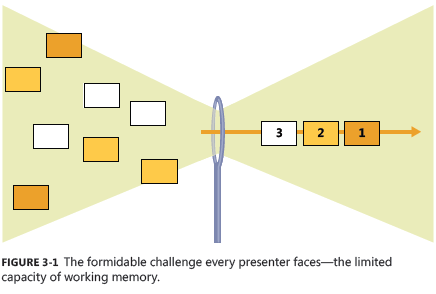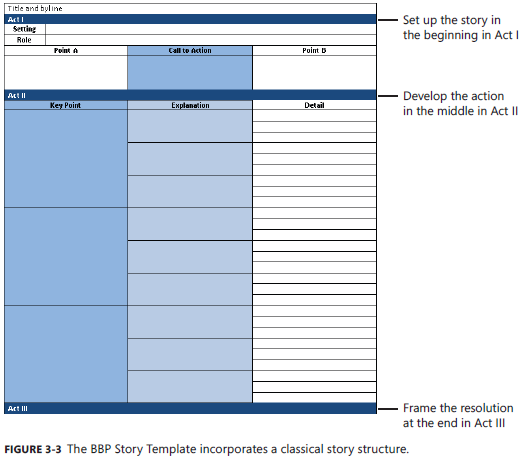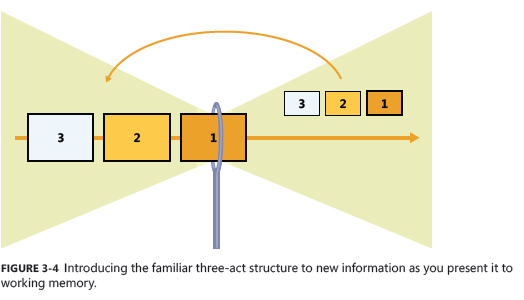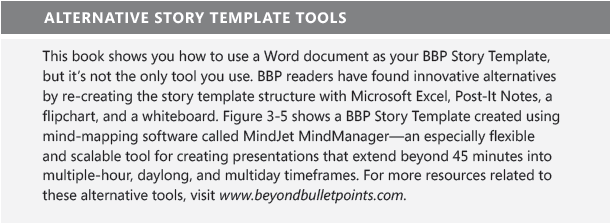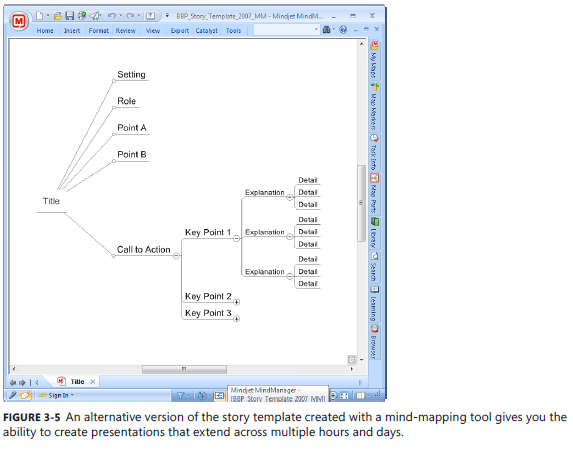New Book: Beyond Bullet Points, 3rd Edition: Using Microsoft PowerPoint to Create Presentations That Inform, Motivate, and Inspire
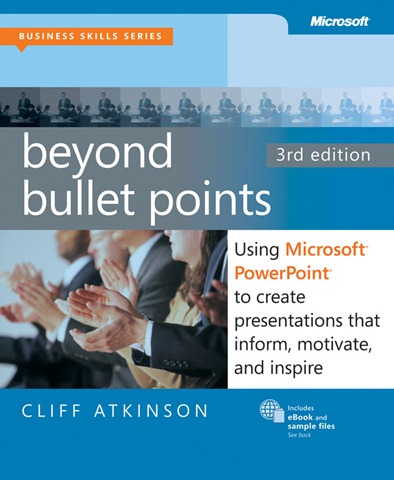 We’re pleased to announce that Cliff Atkinson’s Beyond Bullet Points, 3rd Edition: Using Microsoft® PowerPoint® to Create Presentations That Inform, Motivate, and Inspire (9780735627352; 352 pages) is now available for purchase.
We’re pleased to announce that Cliff Atkinson’s Beyond Bullet Points, 3rd Edition: Using Microsoft® PowerPoint® to Create Presentations That Inform, Motivate, and Inspire (9780735627352; 352 pages) is now available for purchase.
You can find more about the book’s introduction and table of contents in this previous post.
Here is an excerpt from Chapter 3, “Building a Foundation with the BBP Story Template”. Enjoy!
CHAPTER 3
Building a Foundation with the BBP Story Template
IN THIS CHAPTER, YOU WILL:
■ Learn how Beyond Bullet Points (BBP) addresses the limited
capacity of your audience’s working memory to process new
information.
■ Review step by step how the BBP Story Template creates the
foundation for your presentation that you will build upon with
your narration and graphics.
■ Prepare the BBP Story Template, and review three ground rules
for writing headlines.
PREPARING A PRESENTATION is complex and difficult from a couple of perspectives. From a presenter’s point of view, you have many
things you want to say and show during a presentation, and you would like your audience to integrate the new information into clear understanding
in long-term memory, as shown in Figure 3-1.
But as you saw in Chapter 2, you also know what is happening from the audience’s point of view in terms of memory. Sensory memory
can see and hear a potentially unlimited amount of verbal and visual information, but only for a fleeting second. Long-term
memory can hold a potentially unlimited amount of information from 30 seconds to up to a lifetime.
Yet the capacity of working memory to handle new information, the eye of the needle, is relatively limited for the few seconds it pays attention
to what you are showing and saying.
That means that effectively communicating a message is not as easy as creating a Microsoft PowerPoint presentation and assuming that you deliver it through an
unobstructed pipeline to the passive minds of your audience. Instead, you have to set PowerPoint myths aside and engage the three research realities you learned about in
Chapter 2—finding the right amount of new information to engage the limited capacity f working memory without overloading it, engaging both the visual and verbal
channels, and guiding the working memory of your audience to help them integrate new information into their long-term memory.
Some of the techniques you will use to accomplish this are new, some you already know, and some are old methods used in new ways. If you’re completely new to using
PowerPoint, you won’t have to unlearn old habits; instead, you’ll find here a better way to use PowerPoint from the start.
What Does the Road Ahead Look Like?
This book shows you step by step how BBP is applied in depth to one specific example presentation on a topic most people can relate to—introducing a new idea—and shows
how BBP handles a situation where you need to both inform and persuade an audience. The example is intended to be delivered as a 45-minute presentation, so you get a sense
of what it takes to produce a presentation that long. You adapt the same BBP process to a wide range of presentation timeframes, topics, contexts, and purposes—Chapter 9
gives you a tour of more examples to review for inspiration.
If you work for yourself or by yourself, you have no choice but to apply BBP on your own, and you’ll do just fine. But you’ll get the most out of the process if you unlock the benefits
it produces for teams. BBP offers organizations a process where they might not have had one before and often aligns PowerPoint with the group’s communications strategy for the first time.
You should get as many people involved in the BBP process as possible, especially team leaders, marketers, graphic designers, and even some of your potential audience members. When BBP
brings together these separate groups, the efficient process of producing presentations increases the speed of decision making, reduces revisions, and improves the quality and impact
of PowerPoint communications for both presenters and audiences.
BBP will also reveal that people on your team have unexpected talents that will surprise you—perhaps computer engineers will turn out to be good at graphic design,
graphic designers will be good at wordsmithing a logical argument, and statisticians will be good at facilitating the social process.
Sewing Up Understanding with BBP
When you face the limited capacity of the working memory of your audience to process new information, a core challenge is not creating the visuals and narration, but rather
determining the underlying structure that will shape those elements in the first place. A structure focuses your ideas and helps you figure out what you want to say and how you want to say it.
That’s where an incredibly powerful structural tool you will use comes into play—the BBP Story Template.
The Heart and Brain of BBP: The Story Template
With the lessons of the dual-channels theory from Chapter 2 in mind, you see that filmmaking
is an appropriate model for designing multimedia presentations because it plans and manages both visual and verbal information simultaneously.
Filmmakers know that the best way to start planning a film is with the written word, in the form of a script.
A script is much shorter and less detailed than a novel because it assumes that the visuals and dialog will play a major role in telling the story. The best scripts distill stories to their
bare essence and strip away anything that does not contribute to a story’s singular focus. When a writer completes a script, the document then becomes a powerful organizing tool
that literally puts everyone on the same page. The script is the starting point for planning and producing visuals and dialog, and it serves as a way for everyone involved in the project
to be clear on what everyone else is saying and doing. If you were a filmmaker and you started filming before you had a script—similar to working on a PowerPoint presentation
without a written structure—you would probably waste time and resources while you changed your focus and figured out the story along the way.
Although putting your thoughts in writing adds a new step to your usual PowerPoint process, doing so will save you time and effort later. When you begin writing your PowerPoint script
in Chapter 4, you won’t have to start with an empty page, because you’ll use the story template shown in Figure 3-2 to guide you every step of the way.
The story template serves as a central organizing tool for the entire presentation.
It is a visual interface for the structure of your presentation, helping you see the big picture on a single page or two before you commit to adding a visual and verbal track to individual slides.
The Built-in Story Structure
To understand the story template, you have to go back in time a few years. The Greek philosopher Aristotle recorded the classical elements of storytelling 2400 years ago, including the concept that a story has a beginning, a middle, and an end. When you adapt this timeless idea to your PowerPoint presentations, you’ll ground your communications in a powerful technique that works.
The story template includes three sections, or acts, that form a classical story structure and correspond to the beginning, middle, and end of your presentation. Each act in the template is delineated by a horizontal black bar extending across the page, as shown in Figure 3-3.
Act I begins your story by setting up all of the essential elements that comprise every story, including the setting, the main character, an unresolved state of affairs, and the desired outcome. Act II drives the story forward by picking up on the unresolved state of affairs in Act I and developing it through the actions and reactions of the main character in response to changing conditions. Act III ends the story by framing a climax and a decision that the main character must face to resolve the situation, revealing something about his or her character. This time-tested structure keeps your audience interested in your presentation and eager to find out what happens next.
This three-part story structure follows natural patterns that underlie the way we think and understand. No one needs special training or technology to understand a classical story
structure because it’s the way humans have been communicating with one another throughout history.
A story structure frames the context for communication and focuses attention by making information specific and relevant to an audience. Story literally ties
together scattered pieces of information. By incorporating these fundamental ideas in your current PowerPoint story, you’ll be building on a solid foundation that ensures your
presentation is focused, clear, and engaging.
As mentioned in Chapter 2, the long-term memory of your audience already contains existing structures that can help working memory organize and integrate new information.
One of the most well-known configurations is this three-act structure that forms the foundation for countless stories, novels, theatrical productions, films, and television
shows. When you tap into this familiar structure that already exists in your audience’s long-term memory and apply it to the structure of the new information you present, as
shown in Figure 3-4, you are well on your way to creating a clear pathway through the limited capacity of working memory.
Theory Becomes Practical
The innovation of the BBP Story Template is that it brings together theory and a process into a practical tool you open up and use to structure and start every presentation.
Everything you do here in the story template shapes the visuals and narration to come and sets up your ideas in a way that preconfigures and aligns information to best prepare
it for its passage through the working memory of your audience. The story template ensures that every presentation accomplishes what you intend—by understanding
your audience members, tailoring your material to them, getting to the point, and establishing a priority and sequence for your ideas.
You don’t have to be an expert storyteller or an expert in cognitive theory; the template makes structuring your story as easy as filling in the blanks. In the cells of the story
template, you’ll write out a complete sentence that describes what is happening at each point in your story, similar to writing a newspaper headline. As you fill in the blanks,
you’ll be writing the actual story that you’ll present. When you’ve finished, you’ll have a completed one-page or two-page script. This process ensures that you stay focused on
your ideas and include all the elements that make up a good story.
When you write your script using the story template, you focus on your ideas first rather than your graphics. After you complete the template in Word, you’ll import the headlines into PowerPoint, where each complete sentence you wrote will become the headline of a slide, as shown in Figure 3-6. This ensures that before you start working in PowerPoint, you already know the main point you intend to make on each slide.
This pivotal technique of turning your story template into a set of PowerPoint slides will help you to transform your written words into the foundation of a visual story. This will make your job of finding visuals easier by establishing exactly what you need to illustrate on every slide, and it will help your audience to understand your new information much faster by indicating clearly in the title area the meaning of every slide.
